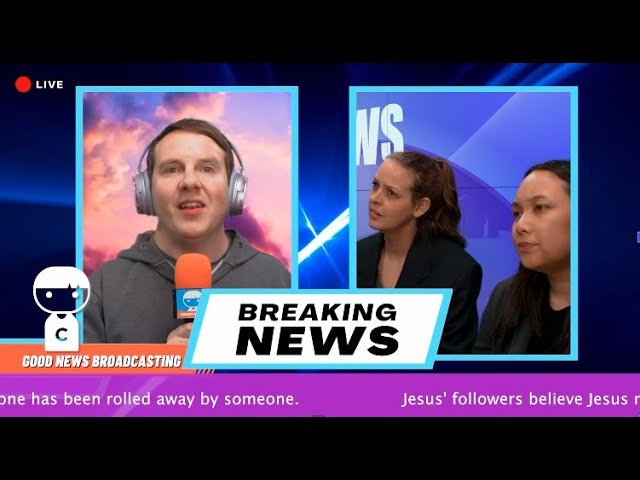
Lesson plans.
Lesson 7: The ten commandments.
Exodus 19:1-20:21 - The Israelites came to Mount Sinai, which Moses climbed to meet with God. There, God gave Moses the Law of the Covenant to give to the Israelites, which was a reminder of how God had rescued them from slavery in Egypt and chosen them to be God’s people, as well as a guideline for how they were to live as God’s people in the Promised Land. God gave the Israelites Ten Commandments to follow, which Jesus later summarizes as “loving God and loving others.”
Lesson 6: Wilderness wanderings.
Exodus 16 - After the Israelites escaped from Egypt and crossed the Red Sea, they wandered through the wilderness to get to the land that God promised to bring them to. Eventually, the Israelites started grumbling against Moses and Aaron, saying that they wished they had stayed in Egypt as slaves because there they had meat to eat and all the food they wanted. God heard the grumbling of the people and sent them bread from heaven, which they called manna, and quail to eat. God instructed them to collect as much manna as needed but not to save any for the next day, because God would provide for them each day. On the night before the Sabbath, they were to collect enough for two days. The people didn’t always listen to God’s instructions, but God continued to take care of them throughout their forty years of wandering in the wilderness.
Lesson 5: Crossing the sea.
Exodus 12:31-42; 13:17-14:31 - After the tenth plague that God sent on Egypt, Pharaoh finally agreed to let the people go. So the Israelites made preparations and started on their journey. However, after the Israelites had left Egypt, Pharaoh changed his mind and sent an army of Egyptians to chase after the Israelites and bring them back. When the Israelites were camped next to the Red Sea, they saw the Egyptian army approaching and were terrified, but Moses told them not to be afraid and to trust God to deliver them. So God told Moses to stretch his hand out over the sea, and God sent a strong wind to blow the waters, causing it to split in two and a path of dry ground to form down the middle. The Israelites were able to cross over on dry ground to the other side, but when the Egyptians tried to follow, God caused the water to come back down, preventing them from getting across.
Lesson 4: The ten plagues.
Exodus 7:1-11:10 - When Pharaoh refuses to listen to Moses and Aaron, who told him to let the Israelite people go free, God begins to send plagues on Egypt, ten in total. First, God turns the Nile river into blood, then God sends frogs, followed by gnats, flies, livestock pestilence, boils, hail, locusts, and darkness. The final plague is the death of all the firstborn sons in Egypt, both humans and animals.
Lesson 3: Moses returns to Egypt.
Exodus 4:18-6:12 - Moses returns to Egypt and meets his brother Aaron whom God has sent to help him speak to the Israelites and to Pharaoh. The two of them speak to the Israelites and tell them that God has sent them to rescue them from slavery. The Israelites, however, don’t believe them, so Moses performs two signs that God gave him to prove that God really sent him. Then, Moses and Aaron go to Pharaoh and demand that he let the people go and take a journey into the wilderness to worship God. Pharaoh is angry and refuses to let the Israelites go, instead making their lives even more miserable by forcing them to meet the same quota of bricks built each day without being given the straw needed to build them. The Israelites are angry at Moses and Aaron, but God promises the Israelites that God will deliver them from Egypt and from their slavery.
Lesson 2: Moses and the burning bush.
Exodus 2:11-4:17 - Moses grew up in the palace of Pharaoh, and one day he went out and saw an Egyptian beating an Israelite, one of his own people. When he thought no one was looking, Moses killed the Egyptian and buried him in the sand. But word got out about what he’d done, and Pharaoh became angry and wanted to kill him. So Moses ran away to a place called Midian, where he met seven daughters of a priest named Jethro. He helped them draw water from a well for their flocks and was invited to their home. Moses married one of the daughters, whose name was Zipporah, and lived with them for many years. One day, when Moses was tending to the flocks in the wilderness, he saw a bush that was caught on fire but didn’t burn up. When he came closer, he heard God speaking to him from the bush. God told Moses that God had not forgotten about the Israelites’ misery and was now sending Moses to go back and rescue them. Moses was afraid and reluctant to go, but God gave him two signs so that the people would listen to him - a staff that turned into a snake and back again, and his hand becoming leprous when placed in his cloak and then healing again.
Lesson 1: The birth of Moses.
Exodus 1:1-2:10 - When the Israelites had lived in Egypt for many years, they prospered and grew in number. The Egyptian Pharaoh was afraid of them, and so he turned them into slaves and oppressed them terribly. Yet the Israelites continued to grow in number, so Pharaoh ordered that all of the Israelite baby boys were to be killed. One Israelite woman, however, took her baby boy and placed him in a basket among the reeds in the Nile River. He was found by the Pharaoh’s daughter, who took pity on him. Meanwhile, the baby’s sister, Miriam, approached Pharaoh’s daughter to ask if she should find a Hebrew woman to nurse the baby. She agreed and the baby was given back to his mother to be nursed. When the baby grew up, he was brought to the Pharaoh’s daughter and became her son, and she named him Moses.
Lesson 4: Mary and Martha.
Luke 10:38-42 - Once Jesus visited the home of Mary and Martha. Mary sat with Jesus and listened to his words, while Martha was busy and distracted with preparations. Martha got frustrated and asked Jesus to tell Mary to come and help her. Jesus answered with compassion, saying that Martha was worried and upset about many things but that only one thing is needed, and that Mary had chosen the better thing, which would not be taken away from her.
Lesson 3: Philip and Nathaniel.
John 1:43-51 - When Jesus went to Galilee, he found Philip and called him to follow him. Philip went and told his friend Nathaniel that he had found the Messiah written about in the Scriptures, Jesus of Nazareth. Nathaniel was surprised to hear that anything good could come from Nazareth, a small and unimportant town. When Nathaniel came to meet Jesus, Jesus spoke as if he already knew Nathaniel, saying "Here is an Israelite in whom there is no deceit." When Jesus told Nathaniel that he saw him sitting under a fig tree earlier, Nathaniel believed that Jesus really was the Messiah and Son of God, but Jesus told them that that they would see even greater things than that.
Lesson 2: The calling of Matthew.
Matthew 9:9-13 - Jesus approached a man named Matthew who was sitting at a tax collector’s booth. He called Matthew to follow him, and Matthew got up and followed. Later, Jesus was having dinner at Matthew’s house, along with many other tax collectors and “sinners”. The Pharisees asked Jesus’ disciples why this was, and when Jesus heard of it, he said that it is not the healthy who need a doctor, but the sick; that God desires mercy not sacrifice; and that he has not come to call the righteous, but sinners.
Lesson 1: Jesus calls his first disciples.
Matthew 4:18-22 - Walking beside the Sea of Galilee, Jesus sees Simon and Andrew, who were fishermen. He calls them to follow him and says that he will send them out to fish for people. They immediately drop their nets and follow him. Jesus then sees James and John, who were also fishermen. When he called them, they too dropped their nets and followed him.
Lesson 5: The empty tomb.
John 20:1-18 - Early in the morning, on the Sunday after Jesus’ death, Mary Magdalene came to visit his tomb but found that it was empty. She thought that someone must have stolen Jesus’ body and so she went to Peter and another one of the disciples to tell them what had happened. They ran to the tomb to see for themselves and found it empty as Mary had said and left. Mary was standing by the tomb weeping when she saw two angels who asked her why she was crying, and she told them that Jesus’ body had been taken away. She then saw a man who she thought was the gardener, and asked him if he saw where they had taken Jesus. When the man said her name, she realized that it was Jesus and that he had risen from the dead, so she ran to tell the rest of the disciples the news.
Lesson 4: Jesus carries his cross.
John 19:17-24 - After Jesus’ arrest and questioning, he is sentenced to death on the cross. He carries his own cross on which Pilate had fastened a sign that said “The King of the Jews.” Some objected to this sign, saying that it should instead say “This man claimed to be king of the Jews.” After Jesus was crucified, the soldiers divided his clothes amongst themselves, which was in fulfillment of a prophesy from the Scriptures.
Lesson 3: Jesus stands before Pilate.
John 18:28-40 - Jesus is arrested and brought to the palace of the Roman governor, Pontius Pilate. He is questioned by Pilate about whether or not he is the King of the Jews. Jesus claims that his kingdom is not of this world, but comes from another place. Pilate does not believe that Jesus is guilty of any wrongdoing, and asks the people if they would like him to be pardoned, but they refuse, and ask to have a criminal named Barabbas pardoned instead.
Lesson 2: Jesus visits the temple.
Matthew 21:12-17 - Jesus and his followers go to the temple in Jerusalem where he turns over the tables of the moneychangers and sellers, incensed that they were turning God’s “house of prayer” into a “den of robbers.” He then heals all the blind and lame who come to him, and the children start shouting praises. When the religious leaders get indignant by this, he reminds them the Scriptures which says that from the lips of children and infants, God has called forth praise.
Lesson 1: Jesus arrives in Jerusalem.
Matthew 21:1-11 - Jesus arrives in Jerusalem with his followers and requests for a donkey to be brought to him, so he can ride into the city on it. This was in fulfillment of the prophesy that the Messiah (promised king and saviour) of Israel would come to them riding on a donkey. A large crowd had gathered at the city gates and were spreading cloaks and palm leaves on the ground in front of Jesus, shouting praises to him as he passed.
Lesson 4: The expensive perfume.
Matthew 26:1-13 - A few days before the Passover, Jesus explained to his disciples what was to come - that he would be handed over to be crucified. The religious leaders had been scheming to have Jesus arrested and killed. Meanwhile, when Jesus was in Bethany, he was at the home of a man named Simon, when a woman took a jar of expensive perfume and poured it on Jesus’ head. The disciples were indignant, feeling that this was a waste, that the perfume could have been sold and the money given to the poor. But Jesus defended the woman, telling them that she had done a beautiful thing for him, preparing his body for burial.



















